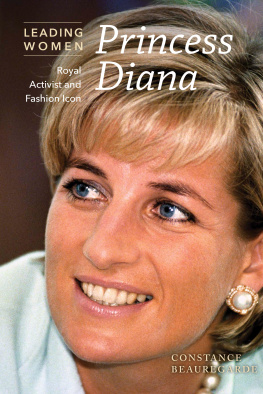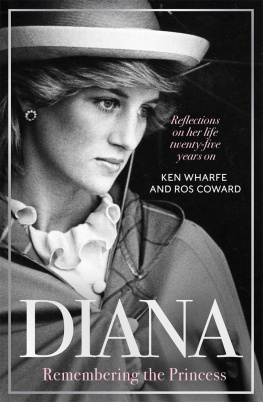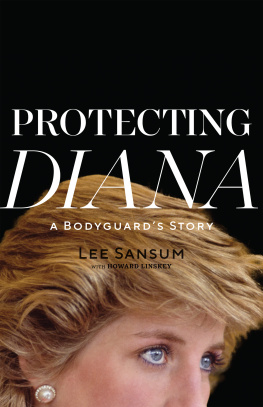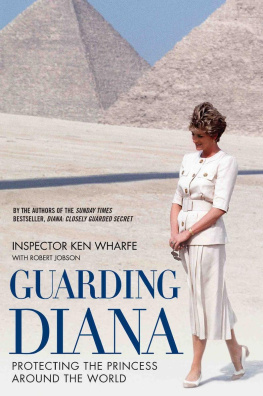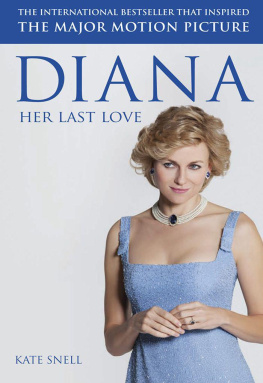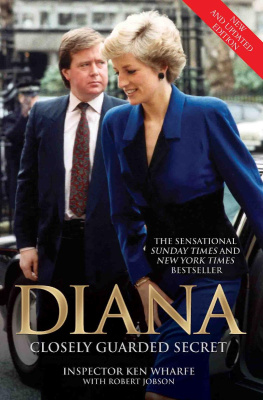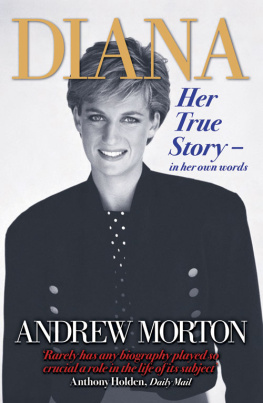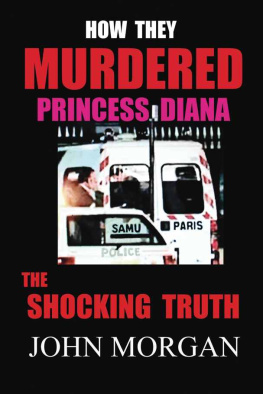I thought long and hard about writing this memoir of the late Diana, Princess of Wales. It was not a decision taken lightly but one I now firmly believe is correct if history is to judge her fairly.
But I could not have written this book without the dedication, wholehearted support and friendship of my co-writer, Robert Jobson, who believed, like me, that this story should be told.
Thanks also to my publisher, Michael OMara, for his guidance and forbearance but above all for believing in me and the project. I would also like to thank the editorial team at Michael OMara Books for their hard work, skill and enthusiasm, particularly my editor Toby Buchan, and Karen Dolan, Rhian McKay and Gabrielle Mander.
This book is written with all the men and women of Scotland Yards Royalty Protection Department in mind. I would like to thank all my friends and colleagues for the friendship and laughter we shared over the years, but above all for their dedication and professionalism which, I believe, cannot be equalled.
NO ONE COULD HAVE FAILED TO APPRECIATE the bitter irony of the day. For years I had been responsible for guarding this woman with my life, if necessary. Now I was in charge of the police security operation for my department at her funeral. Standing, before the service, at the West Door of Westminster Abbey on Saturday, 6 September 1997, was like being a camera recording a scene in a tragic Hollywood movie. The difference, of course, was that this was painfully real. Everything seemed to be played out in slow motion. The organ resounded to William Harriss Prelude; the bells rang out hollowly as the great and the good from princes and prime ministers to so-called ordinary people arrived to pay their last respects to an extraordinary person.
Diana, Princess of Wales had made the latter part of the twentieth century her own. In the last two decades of that century, probably only Nelson Mandela approached her in terms of the interest she generated around the world. Now, after thirty-six years, her Camelot was in ruins and the magic, I was sure, would never return. I kept thinking to myself, How on earth can this be happening? As the pallbearers Welsh Guardsmen, as was fitting struggled with her lead-lined coffin, it seemed almost inconceivable that the radiant young woman who had once charmed the world was lying silently within it, completely at peace for perhaps the only time in her all too short life. That life had been snuffed out by a combination of high spirits, stupidity and human error. That her death was avoidable made me angry, yet the whole sorry episode had numbed me inside, as it had most of the rest of the world. All I could think was, What a waste, what a terrible, utter waste.
Her sons, whom I had once guarded before I became her own personal protection officer, were nothing if not brave. She would have been supremely proud of the way they stood tall in the face of such terrible adversity. I had often played with them during their childhood. They had always loved to throw themselves into play fights; now they faced the greatest test of their lives. In their dark suits, focused in their grief, they looked like men, not boys, as they walked behind their mothers coffin. On the flag-draped coffin a handwritten card lay among a cloud of lilies. On it, the single word Mummy seemed to say everything.
A great calm fell over Central London that morning as millions took to the streets to pay their respects, lining the route along which the Princesss coffin would be borne, on a gun carriage, from Kensington Palace to the Abbey. As I walked to the Abbey from Buckingham Palace with the roads closed, there was no other way of getting there the scent of flowers was heavy on the air. Dianas coffin had been moved from the Chapel Royal, St Jamess Palace, where she had lain, to Kensington Palace at some time the previous evening. Everywhere her famous face peered out from the thousands of newspaper and magazine special editions being sold on the streets to mark the historic event. The nation had come to a complete halt as television coverage poured into millions of homes; around the world, more than two billion people sat and watched an event that many had believed they would not themselves live to see. At variance with the sombre mood, the mourners, many in jeans and T-shirts, were bathed in warm sunshine. Thousands upon thousands packed the funeral procession route as the muffled sound of the bells of Westminster Abbey, which tolled throughout the procession, carried mournfully over the near-silent capital.
Behind the coffin, the procession was led by her two sons, with the Prince of Wales, the Duke of Edinburgh, and her brother, Earl Spencer, heads bowed, walking with them. The tension was electric. As the gun-carriage passed on to the Mall, past Buckingham Palace, the Queen, who had been publicly attacked for her cool response since the death of the Princess, led other members of the royal family who, standing in front of the palace, all bowed as it passed. Above them, from the flagstaff on the Palace roof, the Union Flag fluttered at half-mast. The Queen had finally relented, after yet more criticism in the days before the funeral, and given the order for the flag to be flown thus, the first time in history that it had done so for the death of anyone other than a monarch.
Behind Dianas sons and her ex-husband, father-in-law and brother followed five hundred selected mourners. They were charity workers, nurses, artists, people from all walks of life representing organisations or causes that the Princess had held dear to her heart. Like so many people, I could not help thinking that this deviation from the practice usually followed at such state events was entirely in keeping with the spirit of my ex-boss, who in life had never greatly relished the pomp and circumstance surrounding royalty.
There were 1,900 invited guests within the spectacular Gothic interior of the Abbey. The sun streamed through its great windows. At just after ten oclock the VIPs began to arrive. Shepherding them to their seats was like a military exercise, and my team had to be alert, not least because some of the worlds leading terrorist targets were gathered within this august medieval structure. Americas First Lady, Hillary Clinton whose husband, President Bill Clinton, was one of countless world leaders who, only hours after her death, had publicly praised Diana and her lifes work examined the tributes of flowers near the entrance as she walked past. Two former prime ministers, Baroness Thatcher and John Major, joined Prime Minister Tony Blair and his wife, Cherie, on the long walk from the West Door to their seats in the Abbey.


